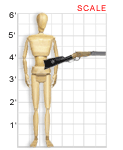From the collection of:
Frazier Historical Arms Museum || VAM Home
New Haven Arms Company (New Haven, Connecticut)
HENRY RIFLE, 1863
.44 rimfire caliber
Serial number 3469
L2002.47
Loaned by Owsley Brown Frazier
Photograph by John Fitzgerald
Courtesy of the Frazier Historical Arms Museum
Roughly 14,000 Henry rifles, based on a design by B. Tyler Henry, were made by the New Haven Arms Company between 1860 and 1866. Henry patented his .44 rimfire lever-action repeating rifle on the eve of the Civil War. While relatively few were used during that war, the rifle was a revolutionary advance in weaponry, gaining a battlefield reputation as the “Yankee rifle that they load on Sunday and fire all week.” It was somewhat tedious to load and was not popular with soldiers, partly because they could not readily transport all the ammunition it could shoot. However, the Union government did purchase about 1,700 Henry rifles. This particular example was presented to Pvt. David Reed in March of 1865 when his company of Veteran Volunteers completed their training.
On July 3, 1863, the last day of battle at Gettysburg, Reed took cover behind a stone wall, at a spot later referred to as the “Bloody Angle.” According to his testimony 20 to 30 years later when he applied for a pension, Reed was carrying ammunition to support Lt. Alonzo Cushing’s battery of cannons positioned on Cemetery Ridge, although there is little other evidence of his actions. When Confederate troops broke the line and surged over the wall, Reed was injured, perhaps by an exploding artillery caisson. Taken prisoner, he was marched to Belle Isle prison on the James River but released in September. In February 1865, he re-enlisted in Company K, 3rd Regiment, Veteran Volunteer Infantry, but saw no further action until his discharge in 1866. This .44 caliber Henry rifle remained his prize possession until his death in 1909.
About the Artist
The Henry evolved out of an earlier repeating rifle produced by the Volcanic Company. The Volcanic arms fired a “rocket ball” bullet with a hollow base containing powder and priming compound. Produced between 1855 and 1860, Volcanic arms were costly, prone to malfunctions, and limited in power, and they never achieved popularity. The company went bankrupt in 1857 and was reorganized as the New Haven Arms Company by Oliver Winchester.
In 1860, B. Tyler Henry, New Haven’s plant superintendent, redesigned the Volcanic action to fire a .44 caliber rimfire brass cartridge loaded with 25 grains of powder behind a 216-grain bullet. After the Civil War, improvements were made to the rifle under Winchester’s direction. The result was the first gun to bear one of the most famous names in rifles, the Winchester.
Classroom Ideas
Discussion: Why do you think this rifle is less elaborately decorated than others shown in the Frazier Historical Arms Museum gallery of the Kentucky Virtual Art Museum? What is its historical significance? Why might it have been Pvt. Reed’s prized possession long after the Civil War?
The breakthrough represented by the Henry rifle was that, instead of a rifle that fired one shot at a time (about three times a minute if you were really good), now you had something that could fire 17 shots in about half that time. Thanks to such technological breakthroughs as the Henry rifle, the railroad, the telegraph, and mass-produced clothing, the desire for speed and time-saving devices quickly became a consumer commodity during and after the Civil War. What types of things do we use today to work faster or save time? What other kinds of time-saving devices can you imagine? The speed of technological change means that most of today’s electronics are outdated in 6 to 18 months. What are some options for recycling outdated equipment?
Activities: Write a fictionalized story with either Reed or inventor Henry as the main character.
Create a timeline showing the developments of technology that made things work faster or saved time.
Links
See a Henry rifle that was presented to President Abraham Lincoln at the Civil War at the Smithsonian site.
[civilwar.si.edu/weapons_henry.html]
The History and Art of Weapons, a guide to the Frazier Historical Arms Museum created by the Louisville Courier-Journal, includes background on the museum itself as well as the history of arms as works of art.
[www.courier-journal.com/cjextra/frazier/]

